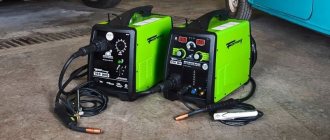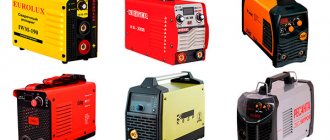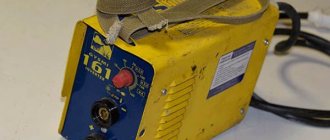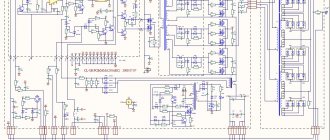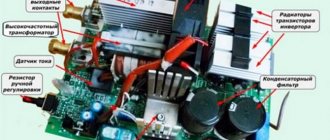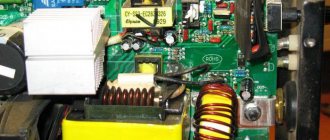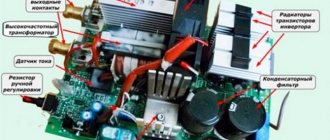Beginning welders are often faced with a choice: what equipment to purchase for work. Knowing the difference between an inverter welding machine and a conventional one, it will be easier to choose a welder. Transformers and high-tech inverter converters have pros and cons. The devices differ in power indicators, functionality, and dimensions.
What is a regular welding machine?
The classic current source for generating an electric arc is a transformer. The welder lowers the mains voltage, and the current increases accordingly. Such equipment was used for manual welding everywhere until the beginning of the 21st century.
The operating principle of the transformer is based on the magnetic induction method. Electric current passing through the first winding magnetizes the core. An electromagnetic field arises, and under the influence of waves an electric current is formed in the wire of the secondary transformer winding. The output voltage depends on the number of secondary turns. The equipment generates high-ampere current with parameters necessary for welding.
Welding transformer layout
Advantages and disadvantages of welding transformers
First, about the advantages of transformer devices:
- simplicity of the device, the scheme of operation is clear to the student;
- maintainability, in case of breakdown the transformer can be repaired independently;
- the ability to work for a long time is ensured by low sensitivity to overheating during operation;
- impact resistance – the risk of mechanical damage during transportation is minimal;
- accessible service;
- low price;
- versatility, the device is used for welding various metals;
- there are no special storage requirements, the transformer is resistant to high humidity and dust.
The disadvantages of traditional welders are obvious:
- when the network sags, the transformer turns off; a stable voltage is needed for power supply;
- lack of precise adjustment of current parameters, large adjustment steps, difficult to set up equipment for welding thin-walled workpieces;
- heavy weight, it is difficult to move the equipment independently;
- significant dimensions;
- high power consumption.
It is worth considering that most transformers operate from a three-phase network. Beginners working with a transformer have problems with arc ignition and sticking. Seams are difficult to form without experience.
Useful video
Watch the video, all the pros and cons of both are collected there:
And another opinion:
Conclusion
We've given you enough information to make your choice. Decide and choose for yourself. You can even try to make a transformer welder with your own hands. But don't forget the good proverb: the miser pays twice.
We wish you success!
Sections: Welding equipment
Tags: Inverter welding machines, transformers
Previous article: Repair of a welding transformer Next article: Welding transformer: device and principle of operation
Which welding machine is better: inverter or transformer
Deciding what is best for welding metal in your own garage or home is not difficult. Comparative characteristics of power supplies will help. First, about the similarities: both are necessary for converting electric current, obtaining operating current parameters, only inverters are equipped with electronic converters.
A short example will help you compare the dimensions of inverter and transformer welding machines. To generate 160 A, you need a transformer weighing 20 kg or an inverter weighing 2.5 kg. The inverter has the highest power, however, transformers have high efficiency.
conclusions
Home craftsmen sometimes stand at a crossroads, unable to decide what equipment to purchase for their needs - a bulky, but cheap transformer unit or a compact, expensive inverter. The first option is rare among modern models, so inverter devices are in great demand among Russian consumers because they are mobile, multifunctional and easy to use.
With constant use, such expensive equipment pays for itself within the first year of operation, but the choice remains with the user.
Other types of welding equipment
A rectifier differs from a transformer apparatus by the presence of semiconductors that rectify the electric current, and welding capabilities are expanded. When changing poles, you can shift the area of maximum heating:
- with straight polarity, the electrode heats up more;
- in the reverse case, the workpieces to be welded are in the welding zone.
The difference between semi-automatic machines is the use of welding wire, which is fed into the heating zone automatically. Semi-automatic devices are created on a transformer and inverter basis. The transformer semiautomatic device with gas equipment is used in auto repair shops and in production; there are no special requirements for storage and transportation conditions. The inverter is more capricious and is necessary for working with thin metal, stainless alloys, and aluminum.
Separately, there are generators that convert the mechanical energy of the engine into electric current. Such devices produce direct and alternating current, operate on mains power and liquid fuel.
Welders prefer transformer devices for large volumes of work. For beginners, it is advisable to purchase small inverter models. Auto repair shops typically require a variety of equipment.
Difference between AC and DC welding
Understanding the differences between alternating and direct current, as well as the features of welding machines that produce them, let’s consider the difference in welding.
AC Welding
DC welding
The arc on alternating current burns less stably; random attenuation is possible with a slight change in the gap between the electrode and the product. There is a characteristic crackling sound. It is more difficult to manipulate the arc, sometimes it “walks”, and it is more difficult to set the shape of the seam.
When welding with alternating current, there is metal spattering, the arc “spits”. AC electrodes are consumed faster. During the execution of ceiling and vertical welds, the transfer of filler metal is complicated; some of it accumulates downwards under the influence of gravity.
But welding machines operating on alternating current are cheaper than rectifiers and inverters. They have the simplest design and internal components that can easily withstand harsh conditions at a construction site, garage, or workshop. There is practically nothing to break here - only the winding can burn out from overheating. If you do not overheat the transformer, it will serve for many years.
The devices are not afraid of dust, and the current strength is adjusted by moving the primary winding closer or further from the secondary. All elements are simple and reliable, the equipment has increased maintainability with low cost of components.
Welding with direct current is characterized by a stable arc, it is easier to weld a seam by controlling the scaliness, width and height of the bead. The arc does not crack, but rustles. Liquid metal splashes less, and the drop is better transferred to the product. Direct current is more convenient for welding not only in the lower position, but also in the vertical and ceiling positions.
When the incoming voltage “jumps,” DC machines only lose operating current, but the arc remains stable. The quality of the weld no longer depends 100% on the experience of the welder, but is ensured by the best characteristics of the welding current.
But inverters are more expensive than transformers. They have more complex internal equipment and expensive repairs. Inverter welding machines are sensitive to dust, shock, and shaking. When using on a construction site or in a workshop, you should be careful and regularly blow dust out of the internal circuits.
Comparison
The main difference between a welding inverter and a traditional welding machine is the presence of a current converter in the first device. In addition, the units under consideration differ in the following aspects:
- weight, dimensions;
- energy efficiency, welding accuracy;
- availability of requirements for storage conditions;
- sensitivity to low temperatures;
- prices, services.
It can be noted that, as a rule, the use of traditional machines requires a more highly qualified welder.
Having determined what the difference is between a welding inverter and a traditional type welding machine, we will reflect in a small table its main criteria in relation to the aspects discussed above.
With your own hands
Practice has shown that some people successfully cope with the independent production of welding rectifiers. The main thing is to develop a workable scheme . The main initial parameters will be the diameters of the electrodes with which the rectifier is designed to work. So, for example, if it is 3 mm, then the welding current must be provided at about 150 A, if it is 4 mm. – 200 A.
The diagram must indicate the parameters of the following elements:
- Transformer. It is advisable to select a circuit from ready-made devices. However, this condition is not easy to fulfill; you have to learn how to make a transformer yourself. Calculating its elements (core cross-section, number of turns on the windings and wire sizes) is not that complicated. Assembly and installation experience is quickly gained after one or two unsuccessful rewinds.
- Rectifier block. Voltage is supplied after the secondary winding of the transformer. The following elements are used for operation: diodes;
- capacitor;
- throttle.
The diodes are assembled using a bridge circuit. After it, the current is not alternating, but pulsating. This current is not suitable for welding, so there is a capacitor . It smoothes out pulsations . Finally, direct current is obtained using a choke. The inductor works as a filter , which passes the direct component of the current, and delays the variable.
Welding rectifier BLUE WELD KING TIG 200
Diodes operating at such high currents generate a lot of heat. Therefore, they are necessarily included in the assembly complete with cooling radiators. It is important to consider forced airflow of the welding machine from a fan.
The capacitors for the welding unit are designed for the maximum ripple voltage. For the rectifier unit, they differ from those used in radio engineering, which do not work with pulsed currents.
Important! Pay close attention to the characteristics.
To make a choke, you need a core made of transformer iron and an insulated copper busbar (you can use a core twisted from tinned copper wires with insulation). The cores can be used from old radio equipment. The choke core and winding are assembled with a gap . After testing the device, the gap and number of turns in the winding can be adjusted.
- Welding rectifier base. The textolite plate has excellent insulating properties. It is not advisable to place devices on it close to each other. During operation, a large amount of heat is generated, so it is necessary to have a sufficiently large ventilated space.
There are many options for making a welding rectifier with your own hands. They will differ in design due to the way they are regulated. The contractor will develop his own design in relation to the specifics of the work performed.
Design
Despite the fact that externally all the equipment is very similar, since it consists of a housing on which there are sensors and adjustment knobs, as well as connected wires and holders, internally welding transformers differ significantly from inverters. Transformers appeared earlier, therefore, they are simpler. They consist mainly of coils, the distance between which is adjusted, changing the amount of current. Its design is simpler and more reliable in operation. Due to the smaller number of parts, breakdowns occur much less frequently here. There is also a dependence on power surges in the network.
The inverter contains a variety of electronics that control the welding process. It can overheat faster, so you need to monitor the temperature of the device, and is also sensitive to shocks, shocks and other damage. They are less reliable in terms of operation, but provide a wider range of parameters. There are often additional functions here due to the design features of the model.
general information
All of them are one way or another aimed at solving one problem - for the permanent fusion of metal parts.
But still, it would be correct to first understand the functional features of each device, and only then evaluate the financial side and size.
This material will highlight the distinctive aspects of a welding inverter and a welding transformer.
Let's hope that the information we provide will help in difficult choices for beginners and amateurs, and will also be useful for professionals.
What is the difference between an inverter and a transformer unit?
If you need to compare whether it is better to work with an inverter or transformer welding machine, you need to understand how difficult one or another welding procedure is, which is more in demand, since both equipment has additional capabilities.
Transformer winding for a welding machine.
The modernized operating mode greatly simplifies the process.
An inverter semi-automatic or transformer is suitable for welding aluminum, stainless steel and other materials with a complex structure. The inverter makes the process easy and fast. It is also easy to transport, care for, and store, since it does not require certain operating conditions.
The transformer apparatus has almost the same characteristics, but the difference lies in the reliability of the seam resulting in a more economical option. The transformer consumes a lot of energy, which makes the inverter more attractive.
For a variety of continuous welding applications, a transformer will be the best option, but it can only handle simple types of fastening.
